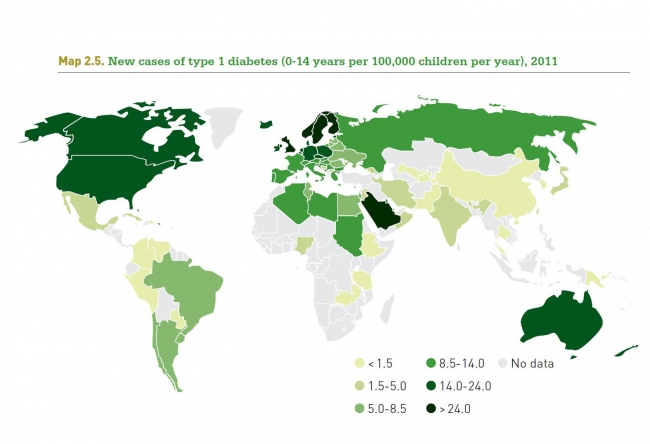Diabetes mellitus type 1 epidemiology and demographics
|
Diabetes mellitus type 1 Microchapters |
|
Differentiating Diabetes mellitus type 1 from other Diseases |
|
Diagnosis |
|
Treatment |
|
Cardiovascular Disease and Risk Management |
|
Case Studies |
|
Diabetes mellitus Main page |
|
Patient Information |
|---|
Editor-In-Chief: C. Michael Gibson, M.S., M.D. [1]
Overview
Epidemiology and demographics of type 1 DM varies with geography, age, race and genetic susceptibility.
Epidemiology and Demographics
Prevalence
- Type 1 diabetes affects ~15-30 million people globally.
- In 2012, Ada estimated the prevalence of type 1 DM in American children and adults at 1.25 million.
Incidence
Incidence of type 1 DM varies with geography, age, race, and genetic susceptibility. Epidemiology and demographics of type 1 diabetes:

b
| Factors affecting the incidence of type 1 DM | Relationship between factors and incidence of type 1 DM | Epidemiology |
|---|---|---|
| Geography | Incidence increases with increase in distance from equator | Incidence of type 1 DM per 100,000 persons a year
0.1 to 0.5 per 100,000 persons in Venezula and parts of China 37 to 65 in Finland and Sardinia 23.6 per 100,000 per year in non-Hispanic white children and adolescents 36 per 100,000 per year in Newfoundland, Canada |
| Age | Bimodal distribution, with one peak at four to six years of age and a second between 10 to 14 years of age. | |
| Gender | Gender doesn't affect the overall incidence of overall incidence of childhood type 1 DM | The prevalence and incidence oftype 1 DM doesn't vary with gender. |
| Genetic susceptibility | There is increased risk of developing type 1 DM in close relatives of a patient with type 1 DM | Lifetime risk of developing Type 1 DM
●No family history – 0.4 percent ●Offspring of an affected mother – 1 to 4 percent ●Offspring of an affected father – 3 to 8 percent ●Offspring with both parents affected – reported as high as 30 percent ●Non-twin sibling of affected patient – 3 to 6 percent ●Dizygotic twin – 8 percent ●Monozygotic twin – 30 percent within 10 years of diagnosis of the first twin, and 65 percent concordance by age 60 years |
| Race | Incidence of type 1 DM varies from race to race | Non-Hispanic white youth-2.55 ases per 1,000 children 0 to 19 years old
African American- 1.62 cases per 1,000 children 0 to 19 years old Hispanic-1.29 cases per 1,000 children 0 to 19 years old Asian-Pacific Islanders-0.6 cases per 1,000 children 0 to 19 years old American Indians-0.35 cases per 1,000 children 0 to 19 years old, respectively) |